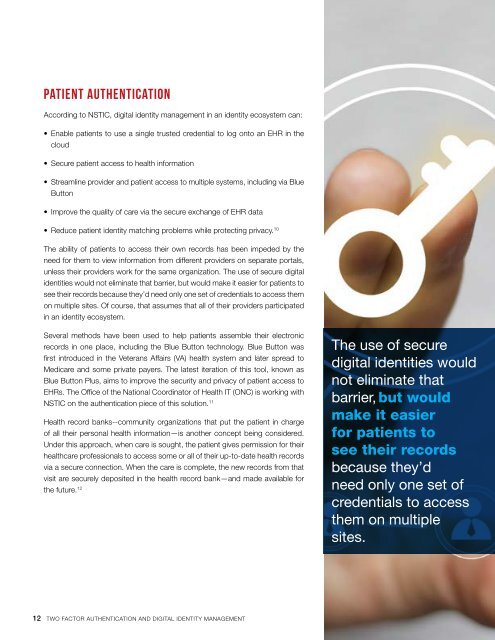Two factor authentication and digital identity management
2izGJqj
2izGJqj
Create successful ePaper yourself
Turn your PDF publications into a flip-book with our unique Google optimized e-Paper software.
Patient <strong>authentication</strong><br />
According to NSTIC, <strong>digital</strong> <strong>identity</strong> <strong>management</strong> in an <strong>identity</strong> ecosystem can:<br />
• Enable patients to use a single trusted credential to log onto an EHR in the<br />
cloud<br />
• Secure patient access to health information<br />
• Streamline provider <strong>and</strong> patient access to multiple systems, including via Blue<br />
Button<br />
• Improve the quality of care via the secure exchange of EHR data<br />
• Reduce patient <strong>identity</strong> matching problems while protecting privacy. 10<br />
The ability of patients to access their own records has been impeded by the<br />
need for them to view information from different providers on separate portals,<br />
unless their providers work for the same organization. The use of secure <strong>digital</strong><br />
identities would not eliminate that barrier, but would make it easier for patients to<br />
see their records because they’d need only one set of credentials to access them<br />
on multiple sites. Of course, that assumes that all of their providers participated<br />
in an <strong>identity</strong> ecosystem.<br />
Several methods have been used to help patients assemble their electronic<br />
records in one place, including the Blue Button technology. Blue Button was<br />
first introduced in the Veterans Affairs (VA) health system <strong>and</strong> later spread to<br />
Medicare <strong>and</strong> some private payers. The latest iteration of this tool, known as<br />
Blue Button Plus, aims to improve the security <strong>and</strong> privacy of patient access to<br />
EHRs. The Office of the National Coordinator of Health IT (ONC) is working with<br />
NSTIC on the <strong>authentication</strong> piece of this solution. 11<br />
Health record banks--community organizations that put the patient in charge<br />
of all their personal health information—is another concept being considered.<br />
Under this approach, when care is sought, the patient gives permission for their<br />
healthcare professionals to access some or all of their up-to-date health records<br />
via a secure connection. When the care is complete, the new records from that<br />
visit are securely deposited in the health record bank—<strong>and</strong> made available for<br />
the future. 12<br />
The use of secure<br />
<strong>digital</strong> identities would<br />
not eliminate that<br />
barrier, but would<br />
make it easier<br />
for patients to<br />
see their records<br />
because they’d<br />
need only one set of<br />
credentials to access<br />
them on multiple<br />
sites.<br />
12 TWO FACTOR AUTHENTICATION AND DIGITAL IDENTITY MANAGEMENT


